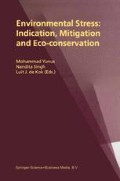Abstract
The study of the effect of copper is of great significance as this has become a wide spread pollutant due to its use as algicide and fungicide in agriculture. Role of rapid industrialisation, urbanisation, mining etc. in increasing copper pollution cannot be ignored. Nature as well as individual organisms have an inherent capacity for maintaining an ecological balance but if the input/generation of these xenobiotic substances or pollutants (like heavy metals) increase above a critical level, they lead to lethal, toxic (acute or chronic) effects depending upon their concentration. In animals excessive intake of copper results in eczema, eye inflammation, mucosal irritation, depression, hepatic, renal and capillary damage whereas in plants higher levels of copper affects osmotic permeability, Hill reactions and causes degradation of chlorophyll and other pigments (Cedeno et al., 1972, 1974; Overnell, 1975). For sustainable development, the heavy metals of aquatic environment can be removed both by chemical and biological means, bioremediation being more ecofriendly. Cyanobacterial biosorption and bioaccumulation has added advantage of CO2 removal — the causal agent of global warming. The preference for photosynthetic prokaryotes in bioremediation is due to their short generation time, access for genetic manipulation and presence of large amount of extracellular metal attractants.
Access this chapter
Tax calculation will be finalised at checkout
Purchases are for personal use only
Preview
Unable to display preview. Download preview PDF.
References
Casatorday, K., Gombos, Z. & Szalontaise, B. 1984. Manganese and cobalt toxicity in chlorophyll biosynthesis. Proceedings of National Academy of Sciences 81: 476–478.
Cedeno, M. & Swader, J.S. 1974. Studies of copper toxicity in Chlore la. Weed Science 22: 443–449.
Cedeno, M., Swader, J.S. & Health, R.L. 1972. The cupric ion as an inhibitor of photosynthetic electron transport in isolated chloroplasts. Plant Physiology 50: 698–700.
Chang, C. & Sibley, T.H. 1993. Accumulation and transfer of copper by Oocystis pusillo. Bulletin of Environmental Contamination & Toxicology 50: 689–695.
De, A.K., Sen, A.K., Modak, D.P. & Jana, S. 1985. Studies of toxic effects of Hg(II) on Pistia stratiotes. Water Air & Soil Pollution 24: 351–360.
Elstener, E.L. & Osswald, W. 1984. Erhtensterben in ‘Reinluftgebieten’ Strukturresistenzverlust. Naturwissenschaftliche Rundschau 37: 52–61.
Hellebust, J.A. & Craige, J.W. 1978. In Handbook of Physiological and Biochemical Methods. Cambridge University Press, Cambridge.
Hughes, E.O., Groham, P.R. & Zehnder 1958. Toxicity of uni-algal cultures of Microcystis aeroginosum. Canadian Journal of Microbiology 4: 225–236.
Jensen, E.T., Baxter, M., Joseph, W. & Jani, V. 1982. Uptake of heavy metals by Plectonames boryanum into cellular compounds especially poly-phosphate bodies. Environmental Pollution (Series A) 27: 119–127.
Lee, L.H., Lustigman, B., Chu, I.U. & Jou, H.L. 1991. Effect of aluminium and pH on the growth of Anacystis nidulens. Bulletin of Environmental Contamination & Toxicology 46: 720–726.
Lee, L.H., Lustigman, B., Chu, LU. & Hsu, S. 1992. Effect of lead and cobalt on the growth of Anacystis nidulens. Bulletin of Environmental Contamination & Toxicology 48: 230–236.
Lee, L.H., Lustigman, B. & Maccari, J. 1993. Effect of copper on the growth of Anacystis nidulens. Bulletin of Environmental Contamination & Toxicology 50: 600–607.
Olafson, R.W., Loya, S. & Sim, R.G. 1980. Physiological parameters of prokaryotic metallothionein induction. Biochemistry & Biophysics Research Communication 95: 1495–1503.
Olafson, R.W. 1984. Prokaryotic metallothionein. Journal of Peptide Protein Research 24: 303–308.
Olafson, R.W., McCubbin, W.D. & Kay, C.M. 1988. Primary and secondary structural analysis of unique prokaryotic metallothionein from Synechococcus species cyanobacterium. Biochemistry Journal 251: 691–699.
Overnell, J. 1975. The effect of heavy metals on photosynthesis and loss of cell potassium in two species of marine algae. Marine Biology 29: 99–103.
Rauser, W.E. 1990. Phytochelatins. Annual Review in Biochemistry 59: 61–86.
Singh, D.P. 1985. Copper transport in the unicellular cyanobacterium Anasystis nidulens. Journal of General and Applied Microbiology 60: 193–196.
Singh, S.P. & Verma, S.K. 1988. Heavy metal uptake in the cyanobacterium Nostoc calcicola. Journal of Indian Botanical Society 67: 74–77.
Sherman, D.M. & Sherman, L.A. 1983. Effect of iron deficiency and iron restoration on the ultrastructure of Anacystis nidulens. Journal of Bacteriology 156: 393–401.
Vos-De, C.H.R. & Schat, H. 1991. Free radical and heavy metal tolerance. In Ecological Responses to Environmental Stresses : 22–30. Kluwer Academic Publishers, Dordrecht.
Wanner, G., Henkelmann, G., Schmidt, A. & Kost, H.P. 1986. Nitrogen and iron starvation of the cyanobacterium Synechococcus 6301 — an ultrastructural, morphological and biochemical comparison. Zeischrift Naturforsch 41C: 741–750.
Editor information
Editors and Affiliations
Rights and permissions
Copyright information
© 2000 Springer Science+Business Media Dordrecht
About this chapter
Cite this chapter
Taneja, L., Fatma, T. (2000). Studies on Potential Use of Cyanobacterium Westiellopsis for Bioremediation of Copper. In: Yunus, M., Singh, N., de Kok, L.J. (eds) Environmental Stress: Indication, Mitigation and Eco-conservation. Springer, Dordrecht. https://doi.org/10.1007/978-94-015-9532-2_33
Download citation
DOI: https://doi.org/10.1007/978-94-015-9532-2_33
Publisher Name: Springer, Dordrecht
Print ISBN: 978-90-481-5503-3
Online ISBN: 978-94-015-9532-2
eBook Packages: Springer Book Archive

